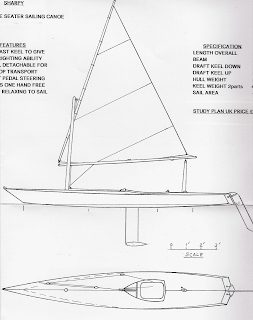 Leeboard
Leeboard Rudder
RudderAs I am about to start building ‘Sharpy’, a 15’ sailing canoe designed by Derek Munion, I thought I would remind myself of the time I modified an Acadia Perception kayak by giving her a sailing rig. The boats are very different. My 12’ 3” Acadia was designed for paddling, and there was never a hint that she should be rigged with a sail and a leeboard, but she did have a standard kick-up rudder.
I happened to find links to a Tasmanian website run by Jeff Jennings. He and members of the Maatsuyker Canoe Club pioneered the use of sails on their sea kayaks, and they became very skilled at using them, even when the sea was rough. Jeff’s website had a page devoted to sail design that gave details of the rigs they used. I made up my own sail, based on one of Jeff’s patterns, and fitted it to a flexible mast, which was nothing more than a length of plastic kitchen drainpipe. This combination worked well. The rig was especially effective in gusty conditions, because wind was automatically spilled from the sail, thus reducing the chances of the kayak being capsized.
I never felt entirely happy with my Acadia, because of my rather slow reactions when trying to keep her upright. If the wind increased, and it became too strong for sailing, I was able to stow the rig on her foredeck, and continue by paddling the kayak.
I feel sure I shall be more relaxed aboard ‘Sharpy’, on account of her ballast keel. As can be expected, she will heel at about 30 degrees when the wind is approaching a Force 3, but unless I do something very foolish, like pressing on under full sail, she should never heel more than 40 degrees. I realize that she could capsize, but the chances of it happening are far less than they would be with ‘Acadia’. As with the latter, I shall be able to paddle ‘Sharpy’ when the going gets too tough for sailing.
Links
Perception ‘Acadia’ Paddling Kayak
http://www.perception.co.uk/product/index/products/recreational/acadia/
Sea Kayaking in Tasmania
http://www.vision.net.au/~jennings/
Kayak Sail Design
http://www.vision.net.au/~jennings/sail/sail.html
Jeff Jennings’s YouTube Channnel (Some amazing videos here)
http://www.youtube.com/user/jeffdjtube
Maatsuyker Canoe Club
http://www.wetdawg.com/pages/clubs_display.php?c=321
‘Sharpy’
http://bills-log.blogspot.com/2010/09/sharpy.html





































